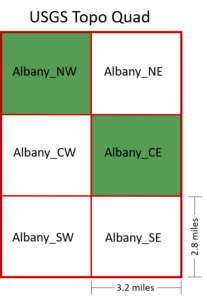Sightings from every block count towards our understanding of birds of the state, but priority blocks are where the focus should be.
For the final year of the Atlas, we ask you to focus your efforts in any remaining incomplete Center East (CE) blocks.
Use the Final Season Block Tool to find a map of blocks labeled by priority level.
Quick Links
- What Are Priority Blocks
- Are Observations in Non-Priority Blocks Valuable?
- Why Are There Priority Blocks?
- How Were Priority Blocks Chosen?
What Are Priority Blocks?

Priority blocks are the center-east and northwest blocks of each topo quad.
Roughly a third of atlas blocks are “priority blocks” and these blocks are where you should focus your atlasing effort if possible. These 1,815 priority blocks are evenly distributed across the state to ensure broad coverage. We need complete coverage of the priority blocks for this atlas to be a success. If you have the option between atlasing in a priority block or a non-priority block, choose the priority block. As a general guide, the center-east and northwest blocks are the priority blocks within each topo quad (exceptions were made for blocks with little to no land in NYS).
For the final year (2024), we ask you to focus on blocks in this order:
- Incomplete Center East (CE) high priority blocks
- Incomplete Northwest (NW) priority blocks
- Complete priority blocks and non-priority blocks
Use the Final Season Block Tool to find a map of blocks labeled by priority level.
Are Observations in Non-Priority Blocks Valuable?
Yes! All breeding records will be analyzed for the atlas, whether they are in a priority block or not. If you can’t get to a priority block, please atlas where you have access. There are some spectacular birding hotspots across the state that don’t fall in a priority block and we fully expect these areas will be atlased by avid birdwatchers. And if you know of a rare species breeding in a non-priority block, please go out and document it for the atlas (being careful not to disturb the birds). All observations count!

Number of survey hours per block in Atlas 2000. St Lawrence, Franklin, and Steuben counties received noticeably less effort than other areas. Even areas like Washington and Seneca counties, which are not that far from population centers, received less coverage. Priority blocks will help smooth out effort across the state.
Why Are There Priority Blocks?
We selected a system of priority blocks that would ensure equal coverage across the state. In the past atlases, some blocks received more effort than others. While this will still be the case this time around, we want to ensure that a sampling of blocks receives a minimum amount of effort even in areas with fewer birders. If we adequately survey all priority blocks, we will be able to get the best statewide trends and distribution data possible.
We also hope that by reducing the amount of volunteer effort required for the project (from all blocks to 1/3 of blocks), we will be free up atlaser efforts so they can provide more thorough coverage of priority blocks.
How Were Priority Blocks Chosen?
Priority blocks were chosen through a long scientific process. Statisticians ran a number of different models with priority blocks chosen in different ways. Each scenario was assessed by how well it could predict a 10% change in population over 20 years for the most species. After looking at all of the options, the one that best fit our data needs and was easy for atlasers to follow is the option we chose. Selecting all center-east and northwest blocks in a systematic manner was the best option and will allow us to meet our science and conservation goals.


